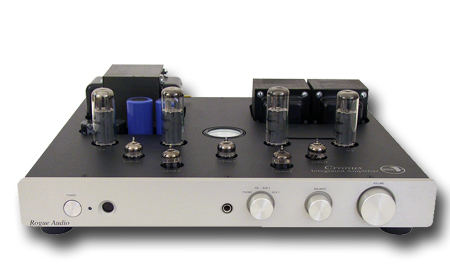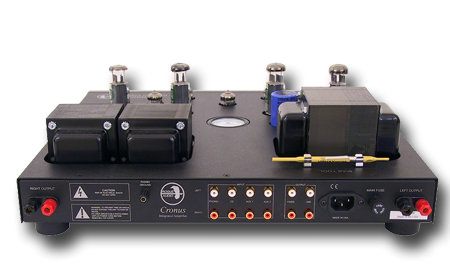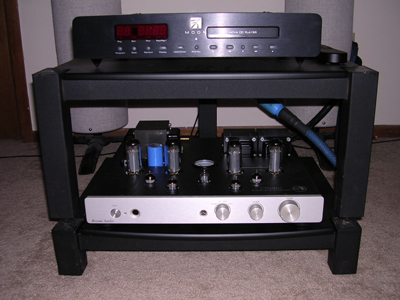You are reading the older HTML site
Positive Feedback
ISSUE
21
rogue audio
Cronos integrated
as reviewed by John Acton

|
JOHN ACTON'S SYSTEM
LOUDSPEAKERS
ELECTRONICS
SOURCES
CABLES
ACCESSORIES
|
In Greek mythology, Cronus was the youngest of the Titans, who were the progenitors of the Greek gods led by Zeus. Cronus ruled the Titans during a Golden Age of peace and prosperity. Like its namesake, the Cronus integrated amplifier is the youngest Rogue Audio product. It joins the Metis preamplifier and Atlas power amplifier in Rogue's new Titan series of entry-level offerings. Like the rest of the Titan lineup, the Cronus is a tube-based component. Despite its low cost, the Cronus is manufactured in the US, as are all Rogue Audio products.
My review sample arrived well packed in a single sturdy box, with foam inserts to protect it. Also included was a small box containing the tubes, along with the remote control, power cord, and replacement fuses. The Cronus is large and heavy, tipping the scales at more than fifty pounds and measuring 18 inches wide by 17.5 inches deep by 5.5 inches high. It is very substantial. The front has a thick, brushed aluminum faceplate, with the rest of the unit finished in black. The all-metal remote control is finished in the same brushed aluminum as the faceplate. My sample came with the optional black metal cage ($100) that protects the tubes from prying fingers. I preferred the look of the amp without the cover.
The Cronus' tube complement consists of four Svetlana EL34s (one pair per channel, operating in push-pull configuration for a rated 55 wpc), two Sovtek 12AX7s, two Electro-Harmonix 12AU7s, and one low-noise NOS 12AU7 for the critical preamp stage. Installing the tubes was simple. The EL34s were labeled with their respective positions, and the only critical issue was to ensure that the NOS preamp tube (labeled "Center" on the box) was installed in the correct socket.

Considering its price, the Cronus is very feature-laden. Almost everything one could realistically ask for is included—a phono stage and headphone output (both solid state), remote control of volume, a balance control, and switching for three line-level sources. The front panel includes rotary knobs for volume, balance, and source selection, and a pushbutton on/off switch. A headphone jack and the remote "eye" complete the package. Around back, there are RCA inputs for the phono and line-level sources, connections for the variable preamp and fixed tape outputs, a ground for the phono stage, and five-way speaker binding posts.
Perhaps because it is an entry-level component, the Cronus does not have multiple binding posts for speakers of different impedances. The amp is factory-set for 8-ohm speakers. Configuring it for 4-ohm speakers requires the owner to remove the top, unhook two wires from the 8-ohm output transformer taps, and hook them up to the 4-ohm taps. Unusual for an entry-level design, the Cronus includes a built-in bias meter, along with a bias wand and pots that allow the output tubes to be individually biased. This means that the Cronus can generate more power from the output tubes than its auto-biasing competitors. The thorough, well-written owner's manual was very helpful in guiding me through the biasing of the amp, which took all of five minutes. I checked the bias every few weeks, but only had to adjust it once during the entire time I had the amp. This is not a high-maintenance design.
The first amp that Rogue Audio provided had a defective preamp tube that produced an overwhelming amount of noise. I made a quick call to Mark O'Brien and Mark Walker at Rogue, who promised that a replacement tube would be immediately shipped to me. Imagine my surprise, then, when the UPS man showed up with a whole new amp! Mark explained that the original amp was a pre-production unit. He had made some revisions to the circuit, and wanted to make sure that I was reviewing a production unit (all production units have the circuit revisions).
The recommended break-in time for the Cronus is 50 to 100 hours. Though it sounded a little hard and brittle right out of the box, it settled down pretty quickly, but even without the benefit of break-in I could tell that this amp was special. On the first night it was in my system, I listened to four CDs straight through, which doesn't happen often. I found that 30 minutes was sufficient warm-up time prior to listening.
The overwhelming characteristic of the Cronus was musicality. The amp was utterly captivating, and though it caused absolutely no listener fatigue, even at high volumes, it possessed a full and open presentation that made late-night, low-volume listening equally satisfying. The Cronus displayed the superb spatial rendering that I've come to expect from a well-implemented tube design. Graham Nash's voice on "Lady of the Island," on Crosby, Stills and Nash (Atlantic 82651-2), is panned just to the inside of the left speaker. With lesser amps, there is a tendency for his voice to wander over to the speaker, destroying the spatial credibility of the performance. With the Cronus, his voice was clearly placed three feet back and just to the side of the speaker. On Steely Dan's Countdown to Ecstasy (MCA MCAD-11887), the vibes on "Razor Boy" were suspended across the soundstage, while Donald Fagen's voice floated in space just right of center. The speakers disappeared, and I was left with nothing but the performance.
With the Cronus, the midrange is the star of the show. The voices on "Helplessly Hoping," also on Crosby, Stills and Nash, were jaw-dropping, and very convincing in their tonality and emotion. The acoustic guitar that anchors the performance sounded so full-bodied and natural that I had to play the song again to revel in its beauty. That's unheard of—I'm a listen-to-the-album-in-its-entirety kind of guy.
 Rosie
Thomas' When We Were Small (Sub Pop SPCD566) showcased the Cronus'
strengths. Her voice was beguilingly present, and full of lit-up warmth.
The emotion of her soul-baring songs was heart-wrenchingly conveyed, and
the magic wasn't limited to her singing—the acoustic guitar and violin
were just as deftly handled. I sat hypnotized throughout the album. The
close-miked piano at the end of the record was so in-the-room that I had
to hear it again. I felt as if I had been transported to a position next
to the piano's soundboard. Stevie Nick's seductively raspy singing on
"Gold Dust Woman," on Fleetwood Mac's Rumours (Warner Bros R2
73882) was flat-out awesome. Everything was there—inflection, tonality,
emotion. Christine McVie's vocals on "Songbird" were dead-on their
timbre and spatial realism.
Rosie
Thomas' When We Were Small (Sub Pop SPCD566) showcased the Cronus'
strengths. Her voice was beguilingly present, and full of lit-up warmth.
The emotion of her soul-baring songs was heart-wrenchingly conveyed, and
the magic wasn't limited to her singing—the acoustic guitar and violin
were just as deftly handled. I sat hypnotized throughout the album. The
close-miked piano at the end of the record was so in-the-room that I had
to hear it again. I felt as if I had been transported to a position next
to the piano's soundboard. Stevie Nick's seductively raspy singing on
"Gold Dust Woman," on Fleetwood Mac's Rumours (Warner Bros R2
73882) was flat-out awesome. Everything was there—inflection, tonality,
emotion. Christine McVie's vocals on "Songbird" were dead-on their
timbre and spatial realism.
I hope you're not inferring from all this that the Cronus is a one-trick pony, at home only with solo piano recitals and folk music. It could kick when needed. The complex, high-octane sequencer and electric guitar interplay on Redshift's Faultline (Distant Sun DS03) was realistically reproduced in all its foundation-cracking glory, though I did find the bass to be a little on the buxom side. The sequencer runs were warmer than I'm used to hearing, as was the bass guitar on Fleetwood Mac's "The Chain." I found the treble natural and extended, but ever so slightly softened or rolled off. This isn't a criticism. Cymbals and sibilants were realistically portrayed, without a trace of edge. Andy Ward's cymbal work on Camel's Moon Madness (Decca 8829312) was clean and airy, with no transient mist or overhang to detract from its veracity. The Cronus' slightly polite upper registers did nothing to ameliorate the excessive vocal sibilance on The Yes Album, on both the newly-remastered domestic issue (Rhino R2 73788) and the Japanese HDCD mini-LP-sleeve CD (Atlantic AMCY-6282).
 The
Cronus was very good at low listening levels, with little compression of
dynamics or diminishing of image size. Because the Cronus sounded so
smooth and natural, I could listen longer (and at higher volumes)
without fatigue. 666 (Vertigo 838 430-2) by Aphrodite's Child is
an ambitious, slightly pretentious interpretation of the Book of
Revelations. Hauntingly beautiful at times, it can also be quite
disturbing, and I need to be in the right frame of mind to truly enjoy
it. On "Loud, Loud, Loud," the piano was warm and full, and was placed
convincingly in the soundstage. The slight warmth of the Cronus helped
flesh out the bass drum on more upbeat songs like "Babylon," while its
superb midrange breathed life into Demis Roussos' scratchy tenor vocals.
The performance was so enthralling that I found myself enjoying this
album at a much higher level than usual.
The
Cronus was very good at low listening levels, with little compression of
dynamics or diminishing of image size. Because the Cronus sounded so
smooth and natural, I could listen longer (and at higher volumes)
without fatigue. 666 (Vertigo 838 430-2) by Aphrodite's Child is
an ambitious, slightly pretentious interpretation of the Book of
Revelations. Hauntingly beautiful at times, it can also be quite
disturbing, and I need to be in the right frame of mind to truly enjoy
it. On "Loud, Loud, Loud," the piano was warm and full, and was placed
convincingly in the soundstage. The slight warmth of the Cronus helped
flesh out the bass drum on more upbeat songs like "Babylon," while its
superb midrange breathed life into Demis Roussos' scratchy tenor vocals.
The performance was so enthralling that I found myself enjoying this
album at a much higher level than usual.
One of the Cronus' gifts was its ability to cope with complex, multi-tracked pop material. Tears for Fears' latest CD, Everybody Loves a Happy Ending (NewDoor B0003042-02), was a perfect example. Dynamically compressed and multi-tracked, it's all too easy for this recording to sound congested. The Cronus did a wonderful job of delineating the musical elements and opening up the soundstage. Roland Orzabal's voice rose out of the mix with greater dimensionality and presence than I'm accustomed to hearing, and again there was that subtle emphasis in the midbass and slight curtailment of the top end that helped flesh out the kick drum and bass guitar while reducing hash and glare.
As thrilled as I was with the Cronus, I did have a few reservations. The first is that I don't like having to disassemble the amp and rewire it if I want to use 4-ohm speakers. However, keep in mind that I'm a reviewer. For listeners, who don't regularly change speakers, this will be a non-issue. Second, I detected a higher-than-usual level of noise from my speakers. It was barely audible at my near-field listening position, and completely inaudible with music playing, but prospective buyers with highly efficient speakers may want to contact Rogue Audio first. Third, I felt that the Cronus performed better with acoustic and more intimate music than it did with raucous, head-banging fare, where I heard an occasional softening of transients and lack of dynamic snap. The amp performed admirably on all types of music, but it set the bar so high when reproducing intimate performances that its slightly reduced capabilities with dynamic music became more obvious.

When I compared the Cronus to the Audio Zone Amp-1 and the Blue Circle NSCS, the Amp-1 was faster and more transparent, with better image focus and greater extension at both ends of the frequency spectrum. The Amp-1 was also better in its retrieval of low-level detail, perhaps due to its lower noise floor. The Cronus, on the other hand, had a larger, more realistic soundstage, and the Amp-1 couldn't quite match its magical midrange and organic musicality. The NSCS, with its greater current capabilities, had a larger dynamic envelope and shared the Amp-1's enhanced ability to retrieve low-level detail. The Blue Circle amp was more extended and had better control in both the bass and treble, but the Cronus surpassed the NSCS in its soundstaging and natural reproduction of midrange instruments. Still, the slight bloom of the NSCS' midrange got it within spitting distance of its tube competitor in that regard.
The Cronus is an impressive amplifier, and while it may represent the lowest rung on the Rogue Audio ladder, it doesn't sound entry-level. I can't overemphasize the Cronus' level of musical involvement. If you want an amp that lays bare every micropscopic detail in your recordings, the Cronus may not be for you, but if you are looking for an amp that draws you into the musical performance, you can't go wrong with this amp. When you factor in the price and all of its standard features, the Cronus is a bona fide bargain. I urge you to listen to it before Rogue Audio comes to their senses and raises the price. John Acton
Cronos integrated
Retail: $1795
Rogue Audio
web address: www.rogueaudio.com
